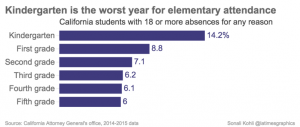California’s Attorney General Kamala Harris this week delivered an impressive report on absenteeism that exposes the scope of the problem across the state but also demonstrates the progress that districts are making toward addressing this problem.
The report, In School On Track 2015, calculates that an estimated 230,000 California elementary students are chronically absent, missing 18 or more days in the 2014-15 school year. That’s 8 percent of elementary students. The study also found:
- More than three quarters of students with chronic attendance problems are low-income.
- The highest rates come in kindergarten where 14.2 percent
of children missed too much school.
- Nearly 20% of African American and Native American elementary school students were chronically absent in the 2014-2015 school year. The rates were even higher in kindergarten where nearly 30 percent of Native American and African American students miss 18 days or more of school, and over 8% of African American kindergartners missed 36 days or more.
- Suspension rates for black elementary school boys were five times higher than those for all other boys. For black girls, the rate was nine times higher than all other girls. Overall, elementary school students in California missed an estimated 110,000 days of school due to suspensions alone.
- California schools are losing an estimated $1 billion a year because state aid is tied to daily attendance.
Many of these findings reinforce the trends we found in our national brief, Mapping the Early Attendance Gap released earlier this month. It’s clear we must look beyond attendance averages to see who is missing too much school, as well as unpack and address major barriers to getting to class.
“It’s not just an issue of education,” Harris said at a gathering before the Los Angeles Chamber of Commerce. “It’s an issue of public safety, and it’s an issue of having a healthy, if not thriving state.”
Harris described how she came to the issue of absenteeism through the lens of a prosecutor trying to determine why so many young men ended up as perpetrators or victims of crime. Dropping out of high school and truancy were common factors in many instances.
Her approach recognizes that courts should be the last resort when dealing with absenteeism. In a series of In School On Track reports over the past three years, Harris calls for prevention and early intervention that reach beyond the schoolyard to engage the entire community.
This year’s edition goes beyond the dire numbers to show that more California school districts are tracking chronic absence – the number and percentage of students missing 10 percent or more of the school year – and using what they find to intervene with students. California now includes this metric as a reporting requirement in its Local Control Accountability Plan.
The report found:
- More than 95 percent of districts surveyed report that they have made changes to policies and programs to improve attendance, or plan to do so in 2015-2016.
- More than 60 percent of districts cited increased awareness as a reason for changes in their attendance programs
- There has been a 10 percentage point increase in districts collecting and monitoring attendance data longitudinally (year over year) since last year’s report (from 72 to 82 percent).
- For the past two years, a quarter of districts each year have changed discipline policies so that students would miss less time in school for suspensions.